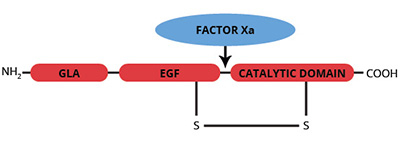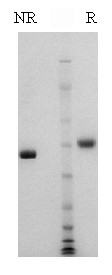Human factor VII is a single chain, vitamin K-dependent, plasma glycoprotein which is synthesized in the liver (1-3). Prior to secretion into the blood, post translational modification by a vitamin K-dependent carboxylase produces ten-carboxyglutamic acid (gla) residues located in the NH2-terminal portion of the molecule, which facilitate cell membrane binding. Factor VII is proteolytically activated to the serine protease, factor VIIa, during coagulation. Factor VII can be activated by thrombin, factor IXa, factor Xa or factor XIIa. The activation results in cleavage of the single chain molecule on the COOH-terminal side of arginine-152, to produce an NH2-terminal derived light chain (Mr=20,000) and a COOH-terminal derived heavy chain (Mr=30,000) which remain covalently associated by a single disulfide bond. The light chain region contains the gla domain, as well as two growth factor domains which are homologous to human epidermal growth factor (EGF). A single β-hydroxyaspartic acid identified in factor VII is also located in the light chain region. The heavy chain region of factor VIIa contains the catalytic domain. Factor VIIa and the cofactor, tissue factor, may combine on negatively charged cell surfaces in a calcium dependent manner to form the extrinsic factor Xase enzyme complex. This enzyme complex catalyzes the conversion of both factor IX to factor IXa and factor X to factor Xa. The cDNA for factor VII has been isolated and the nucleotide sequence determined (4). Factor VII shares extensive sequence homology with other serine proteases including factor IX, factor X and protein C.
Human factor VII is purified using a combination of conventional techniques (2) and immunoaffinity chromatography (5). The purified protein is supplied in 50% (vol/vol) glycerol/H2O and should be stored at -20oC. Purity is determined by SDS-PAGE analysis and activity is measured in a factor VII clotting assay.


